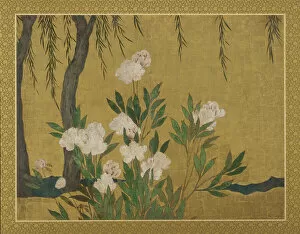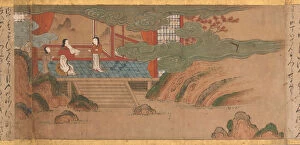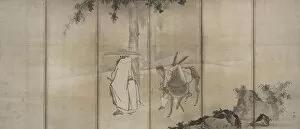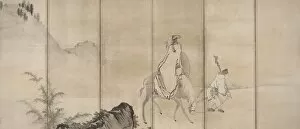Momoyama Period Collection
The Momoyama period, also known as the Edo period, was a vibrant and culturally rich era in Japanese history that took place during the early 17th century
For sale as Licensed Images
Choose your image, Select your licence and Download the media
The Momoyama period, also known as the Edo period, was a vibrant and culturally rich era in Japanese history that took place during the early 17th century. This period saw the rise of influential artists such as Hasegawa Tonin and Kano Shoei, who created stunning works like "Peonies and Willows" and "Birds, Trees, and Flowers, " respectively. One remarkable artifact from this time is a makimono box adorned with scenes from the Genji romance. The intricate details on this piece showcase the artistic prowess of craftsmen during the Momoyama period. Nature played a significant role in art during this era. A bird perched on a bamboo stump captures the delicate balance between wildlife and its natural habitat. Similarly, coxcombs, maize, morning-glories depict an array of flora that flourished during this time. Scenes from "The Tale of Genji" were also popular subjects for artwork in the Momoyama period. These depictions transported viewers into captivating narratives filled with love, betrayal, and adventure. Animals were often portrayed to symbolize strength or nobility. A horse accompanied by an attendant showcases their importance in society at that time. Likewise, a dragon amidst waves and clouds represents power and auspiciousness. Functional objects were not exempt from artistic embellishment either; a tebako (box for personal accessories) exemplifies how even everyday items became canvases for creativity during this period. Portraits were another common theme in Momoyama artistry; one notable example is "The Poet Kakinomoto no Hitomaro. " This depiction immortalizes an esteemed poet whose words continue to resonate throughout generations. Lastly, two pheasants resting on a snow bank capture both beauty and tranquility within nature's wintry embrace. Meanwhile, a horse mounted by its rider signifies bravery amidst uncertain times—a reflection of Japan's historical context during the Momoyama period.
















































